
The Gallo-Romance branch of the Romance languages includes in the narrowest sense the langues d'oïl and Franco-Provençal. However, other definitions are far broader and variously encompass the Occitan or Occitano-Romance, Gallo-Italic or Rhaeto-Romance languages.
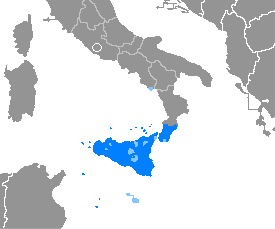
Sicilian is a Romance language that is spoken on the island of Sicily and its satellite islands. A variant, Calabro-Sicilian, is spoken in southern Calabria, where it is called Southern Calabro notably in the Metropolitan City of Reggio Calabria. Dialects of central and southern Calabria, the southern parts of Apulia and southern Salerno in Campania, on the Italian peninsula, are viewed by some linguists as forming with Sicilian dialects a broader Extreme Southern Italian language group.

Piedmontese is a language spoken by some 2,000,000 people mostly in Piedmont, a region of Northwest Italy. Although considered by most linguists a separate language, in Italy it is often mistakenly regarded as an Italian dialect. It is linguistically included in the Gallo-Italic languages group of Northern Italy, which would make it part of the wider western group of Romance languages, which also includes French, Occitan, and Catalan. It is spoken in the core of Piedmont, in northwestern Liguria, near Savona and in Lombardy.

Lombard is a language belonging to the Gallo-Italic family and consisting of a cluster of homogeneous dialects spoken by millions of speakers in Northern Italy and Southern Switzerland, including most of Lombardy and some areas of the neighbouring regions, notably the eastern side of Piedmont and the western side of Trentino, and in Switzerland in the cantons of Ticino and Graubünden. It is also spoken in Santa Catarina in Brazil by Lombard immigrants from the Province of Bergamo.

Southern Italy also known as Meridione or Mezzogiorno, is a macroregion of Italy consisting of its southern regions.

Sicilians or the Sicilian people are a Romance speaking ethnic group who are indigenous to the island of Sicily, the largest island in the Mediterranean Sea, as well as the largest and most populous of the autonomous regions of Italy.

Butera is an Italian town and a comune in the province of Caltanissetta, in the southern part of the island of Sicily. It is bounded by the comuni of Gela, Licata, Mazzarino, Ravanusa and Riesi. It has a population of 4,653 (2017) and is 49 km (30 mi) from Caltanissetta, the province's capital.
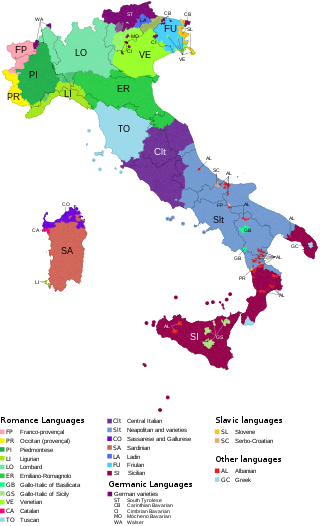
The languages of Italy include Italian, which serves as the country's national language, in its standard and regional forms, as well as numerous local and regional languages, most of which, like Italian, belong to the broader Romance group. The majority of languages often labeled as regional are distributed in a continuum across the regions' administrative boundaries, with speakers from one locale within a single region being typically aware of the features distinguishing their own variety from one of the other places nearby.
The Ticinese dialect is the set of dialects, belonging to the Alpine and Western branch of the Lombard language, spoken in the northern part of the Canton of Ticino (Sopraceneri); the dialects of the region can generally vary from valley to valley, often even between single localities, while retaining the mutual intelligibility that is typical of the Lombard linguistic continuum.

The Gallo-Italic, Gallo-Italian, Gallo-Cisalpine or simply Cisalpine languages constitute the majority of the Romance languages of northern Italy: Piedmontese, Lombard, Emilian, Ligurian, and Romagnol. In central Italy they are spoken in the northern Marches ; in southern Italy in some language island in Basilicata and Sicily.

Northern Italy is a geographical and cultural region in the northern part of Italy. It consists of eight administrative regions: Aosta Valley, Piedmont, Liguria, Lombardy, Emilia-Romagna, Veneto, Friuli-Venezia Giulia and Trentino-Alto Adige. As of 2014, its population was 27,801,460. Rhaeto-Romance and Gallo-Italic languages are spoken in the region, as opposed to the Italo-Dalmatian languages spoken in the rest of Italy. The Venetian language is sometimes considered to be part of the Italo-Dalmatian languages, but some major publications such as Ethnologue and Glottolog define it as Gallo-Italic.

Ligurian or Genoese is a Gallo-Italic language spoken primarily in the territories of the former Republic of Genoa, now comprising the area of Liguria in Northern Italy, parts of the Mediterranean coastal zone of France, Monaco, the village of Bonifacio in Corsica, and in the villages of Carloforte on San Pietro Island and Calasetta on Sant'Antioco Island off the coast of southwestern Sardinia. It is part of the Gallo-Italic and Western Romance dialect continuum. Although part of Gallo-Italic, it exhibits several features of the Italo-Romance group of central and southern Italy. Zeneize, spoken in Genoa, the capital of Liguria, is the language's prestige dialect on which the standard is based.

Italo-Western is, in some classifications, the largest branch of the Romance languages. It comprises two of the branches of Romance languages: Italo-Dalmatian and Western Romance. It excludes the Sardinian language and Eastern Romance.

Piazza Armerina is a comune in the province of Enna of the autonomous island region of Sicily, southern Italy.

Nicosia is a Town and comune of the province of Enna in Sicily, southern Italy. It is located at 720 m above the sea level, on a rocky massive culminating in four imposing hills. The origin of Nicosia is uncertain. Nicosia and Troina are the northernmost towns in the province of Enna. The vicinity was traditionally made up of salt mines and arable lands.
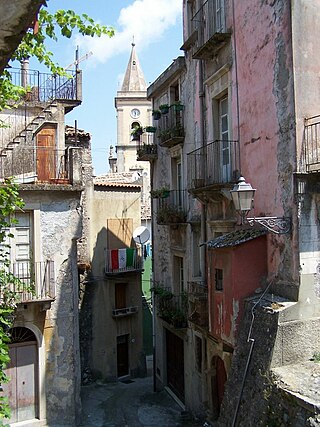
Novara di Sicilia is a comune (municipality) in the Metropolitan City of Messina in the Italian region of Sicily, located about 160 kilometres (99 mi) east of Palermo and some 40 kilometres (25 mi) southwest of Messina.

San Fratello, formerly San Filadelfo, is a comune (municipality) in the Metropolitan City of Messina in the Italian region Sicily, located about 110 kilometres (68 mi) east of Palermo and about 90 kilometres (56 mi) west of Messina. San Fratello borders the following municipalities: Acquedolci, Alcara li Fusi, Caronia, Cesarò, Militello Rosmarino, Sant'Agata di Militello.
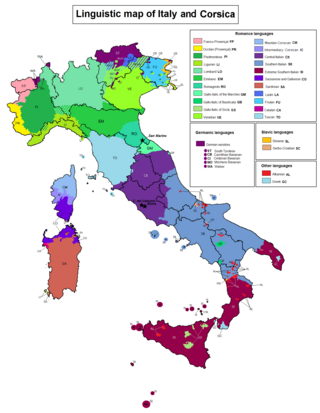
Gallo-Italic of Sicily is a group of Gallo-Italic languages found in about 15 isolated communities of central eastern Sicily. Forming a language island in the otherwise Sicilian language area, it dates back to migrations from northern Italy during the reign of Norman Roger I of Sicily and his successors.

Western Romance languages are one of the two subdivisions of a proposed subdivision of the Romance languages based on the La Spezia–Rimini Line. They include the Gallo-Romance and Iberian Romance branches. Gallo-Italic may also be included. The subdivision is based mainly on the use of the "s" for pluralization, the weakening of some consonants and the pronunciation of “Soft C” as /t͡s/ rather than /t͡ʃ/ as in Italian and Romanian.
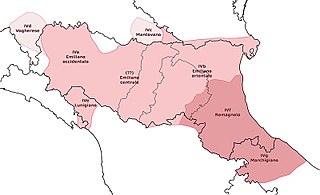
Emilian is a Gallo-Italic language spoken in the historical region of Emilia, which is now in the northwestern part of Emilia-Romagna, Northern Italy. There is no standardised version of Emilian.


















